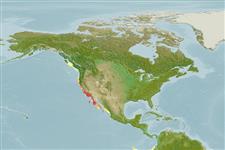Environment: milieu / climate zone / Tiefenbereich / distribution range
Ökologie
seewasser demersal; tiefenbereich 4 - 450 m (Ref. 96339), usually 55 - 244 m (Ref. 96339). Subtropical
Eastern Pacific: southern Oregon, USA to central Baja California, Mexico.
Size / Gewicht / Alter
Geschlechtsreife: Lm ? range ? - ? cm
Max length : 25.0 cm TL Männchen/unbestimmt; (Ref. 2850)
Mostly found on mud bottom from 55-244 m depth. Polychaete worms appear to be the preferred food, but euphausiids, amphipods, and fish eggs have been found in their stomachs (Ref. 4525).
Life cycle and mating behavior
Geschlechtsreife | Fortpflanzung | Ablaichen | Eier | Fecundity | Larven
Eschmeyer, W.N., E.S. Herald and H. Hammann, 1983. A field guide to Pacific coast fishes of North America. Boston (MA, USA): Houghton Mifflin Company. xii+336 p. (Ref. 2850)
IUCN Rote Liste Status (Ref. 130435: Version 2025-1)
Bedrohung für Menschen
Harmless
Nutzung durch Menschen
Fischereien: bycatch
Tools
Zusatzinformationen
Download XML
Internet Quellen
Estimates based on models
Preferred temperature (Ref.
123201): 8.1 - 16.7, mean 10.8 °C (based on 36 cells).
Phylogenetic diversity index (Ref.
82804): PD
50 = 0.8750 [Uniqueness, from 0.5 = low to 2.0 = high].
Bayesian length-weight: a=0.00389 (0.00152 - 0.00995), b=3.15 (2.92 - 3.38), in cm total length, based on LWR estimates for this (Sub)family-body shape (Ref.
93245).
Trophic level (Ref.
69278): 3.4 ±0.40 se; based on food items.
Generation time: 4.1 ( na - na) years. Estimated as median ln(3)/K based on 1
growth studies.
Widerstandsfähigkeit (Ref.
120179): mittel, Verdopplung der Population dauert 1,4 - 4,4 Jahre. (K=0.27).
Fishing Vulnerability (Ref.
59153): Moderate vulnerability (37 of 100).
🛈
